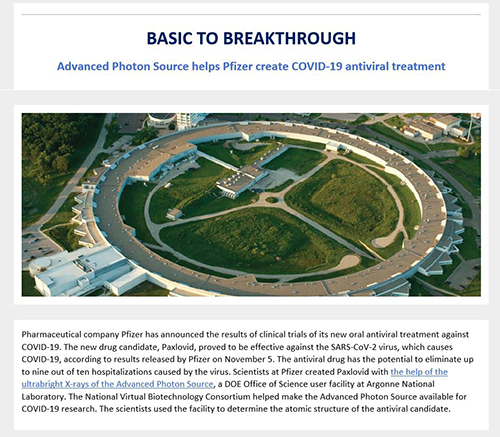
A new drug candidate, Paxlovid, which has proven to be effective against the SARS-CoV-2 virus, and a superionic ice that is neither liquid nor solid, both based on research at the Advanced Photon Source (APS), are featured in the November 15, 2021 issue of the U. S. Department of Energy (DOE) “Communique” e-newsletter.
Stephen Streiffer, Argonne Deputy Laboratory Director for Science & Technology and Interim Associate Laboratory Director for Photon Sciences, called this “great recognition for our users and for the APS!”
The “Communique” Basic Breakthrough section reports that the “Advanced Photon Source helps Pfizer create COVID-19 antiviral treatment. Pharmaceutical company Pfizer has announced the results of clinical trials of its new oral antiviral treatment against COVID-19. The new drug candidate, Paxlovid, proved to be effective against the SARS-CoV-2 virus, which causes COVID-19, according to results released by Pfizer on November 5. The antiviral drug has the potential to eliminate up to nine out of ten hospitalizations caused by the virus. Scientists at Pfizer created Paxlovid with the help of the ultrabright X-rays of the Advanced Photon Source, a DOE Office of Science user facility at Argonne National Laboratory. The National Virtual Biotechnology Consortium helped make the Advanced Photon Source available for COVID-19 research. The scientists used the facility to determine the atomic structure of the antiviral candidate.” This breakthrough research was carried out at the Industrial Macromolecular Crystallography Association Collaborative Access Team (IMCA-CAT) beamline at the APS, operated by the Hauptman-Woodward Medical Research Institute (HWI) on behalf of a collaboration of pharmaceutical companies, of which Pfizer is a member.
Under the heading “In the News,” Strange, dark, and hot ice could explain Uranus and Neptune’s wonky magnetic fields links to the Popular Science article about a layer of “hot,” electrically conductive ice that could be responsible for generating the magnetic fields of ice giant planets like Uranus and Neptune. This work from the Carnegie Institute for Science and the University of Chicago Center for Advanced Radiation Sources researchers was carried out at the GeoSoilEnviroCARS 13-ID x-ray beamline at the DOE’s APS. The study, published in Nature Physics, reveals the conditions under which two such superionic ices form. More on this subject can be found on the APS web site, the Carnegie Institute for Science web site, and the University of Chicago web site.
The U.S. Department of Energy's APS at Argonne National Laboratory is one of the world’s most productive x-ray light source facilities. Each year, the APS provides high-brightness x-ray beams to a diverse community of more than 5,000 researchers in materials science, chemistry, condensed matter physics, the life and environmental sciences, and applied research. Researchers using the APS produce over 2,000 publications each year detailing impactful discoveries, and solve more vital biological protein structures than users of any other x-ray light source research facility. APS x-rays are ideally suited for explorations of materials and biological structures; elemental distribution; chemical, magnetic, electronic states; and a wide range of technologically important engineering systems from batteries to fuel injector sprays, all of which are the foundations of our nation’s economic, technological, and physical well-being.
Argonne National Laboratory seeks solutions to pressing national problems in science and technology. The nation's first national laboratory, Argonne conducts leading-edge basic and applied scientific research in virtually every scientific discipline. Argonne researchers work closely with researchers from hundreds of companies, universities, and federal, state and municipal agencies to help them solve their specific problems, advance America's scientific leadership and prepare the nation for a better future. With employees from more than 60 nations, Argonne is managed by UChicago Argonne, LLC, for the U.S. DOE Office of Science.
The U.S. Department of Energy's Office of Science is the single largest supporter of basic research in the physical sciences in the United States and is working to address some of the most pressing challenges of our time. For more information, visit the Office of Science website.
